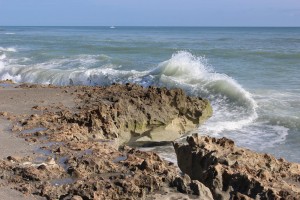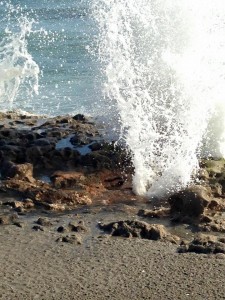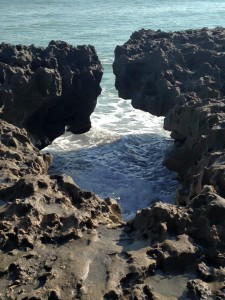Posted October 27, 2015
By DIANA RODON
JUPITER ISLAND, Fla. — A walk through the sea grape tunnel path leads up to the beautiful, rocky beach located here, just two hours north of Miami. The sun shines through the leaves and branches of the tunnel, giving beach-goers a feeling of the isolated place they are about stumble upon.
 As you exit the tunnel and come upon the elevated, wooden bridge entrance to the beach the view of the beach is completely obscured but the sound of breaking waves can be heard.
As you exit the tunnel and come upon the elevated, wooden bridge entrance to the beach the view of the beach is completely obscured but the sound of breaking waves can be heard.
Blowing Rocks Preserve, located in Hobe Sound on Jupiter Island, Fla., is a different kind of beach from what would usually be found in South Florida.
The beach is a barrier island sanctuary owned by non-profit organization The Nature Conservancy. It is serene and isolated; the loudest sound coming from the breaking waves. There is not a bikini to be spotted or a bare foot. At Blowing Rocks, beach-goers are equipped with hiking sneakers, so they can climb onto the limestone rock formations that obscure the beach’s shores.
“I was told about [Blowing Rocks] by a friend,” said Lincoln Rodon, a Miami native and first-time visitor to the beach. “I became really interested because I had no idea there was something like that in South Florida. It was everything I was told it would be.”
Those who visit Blowing Rocks at high tide will be able to witness the immense waves that crash into the limestone. The rock formations occur naturally in different shapes, sometimes creating small holes that the water splashes through. During a big enough wave water shoots through these holes forcefully like a geyser. The waves, when paired with strong winds, can get very powerful. Waves of this height, reaching up to 50 feet during storms, do not usually occur on beaches in Miami.
 “I went to Blowing Rocks Preserve over Fall Break,” said David Colbus, a senior studying anthropology at the University of Miami. “I was told there would be waves and rocks to climb on so I was excited to check it out. I enjoyed watching people jump back, startled by the waves crashing and sending spray above their heads.”
“I went to Blowing Rocks Preserve over Fall Break,” said David Colbus, a senior studying anthropology at the University of Miami. “I was told there would be waves and rocks to climb on so I was excited to check it out. I enjoyed watching people jump back, startled by the waves crashing and sending spray above their heads.”
The rocks seem to grow larger the further you go down the beach. At the front of the beach there are not many rocks but the waves remain strong.
The only swimmers are children spotted squatting on the shoreline, ready to get swept up by the waves. During low tide Blowing Rocks becomes a much safer ocean in which to swim.
Low tide offers something completely different for the average beach-goer. The waves do not get large enough to crash into the limestone during low tide allowing people to walk along the shore and explore the caves of rock. During the low tide there is a good chance that you can catch a glimpse at any number of different sea creatures on the shore, such as large turtles.
“I wanted to see the caves of limestone but that was only during low tide,” said Isabel Rodon who has visited Jupiter many times but had never been to Blowing Rocks Preserve. “We discovered other things though besides the caverns that we didn’t expect like the turtles and schools of fish in the waves and what the beach is known for, which is the waves that crash into the side of the limestone, sometimes shooting up through it like a geyser.”
 Yet even during high tide the heads of turtles and large fins of undistinguished species of fish can be seen bobbing up and down as the waves seep in and out.
Yet even during high tide the heads of turtles and large fins of undistinguished species of fish can be seen bobbing up and down as the waves seep in and out.
Despite the sheer size and sound of the waves, they are serene. The light from the sun hits the waves and creates a glare of ripples. When schools of fish travel within an enormous wave they can be confused for some of these rippling effects.
Of the few visitors many seem to be locals, taking advantage of the scenic beach in their virtual backyard by going for a stroll.
To newcomers, breathtaking views and unusual scenery continue to attract those looking for something different to see and do in South Florida.
Blowing Rocks Preserve is a hidden gem, isolated from many and deserving of far more visitors.
If You Go
- Best Times to Visit: Check the times for low and high tides. Be advised that the beach opens at 9 a.m. and closes at 4:30 p.m., which does not always coincide with the best times to view the high or low tides.
- http://www.weatherforyou.com/reports/index.php?forecast=tides&place=blowing+rock+park&state=fl&icao=KSUA
- Directions: 574 South Beach Road, Hobe Sound, Fla. 33455. Take I-95 North to Palm Beach Gardens. Take exit 79A for FL-786 E/PGA Boulevard. Make a slight right onto Lake Victoria Gardens. Turn right onto FL-811 North. Continue onto South Beach Road. The destination will be on the right.
- For more information: http://www.nature.org/ourinitiatives/regions/northamerica/unitedstates/florida/placesweprotect/blowing-rocks-preserve.xml
